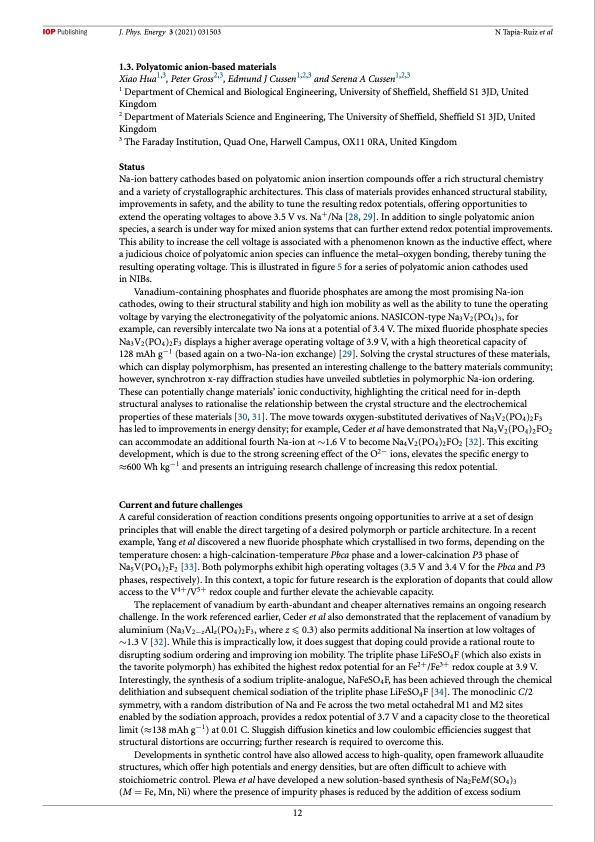
PDF Publication Title:
Text from PDF Page: 013
J. Phys. Energy 3 (2021) 031503 N Tapia-Ruiz et al 1.3. Polyatomic anion-based materials Xiao Hua1,3, Peter Gross2,3, Edmund J Cussen1,2,3 and Serena A Cussen1,2,3 1 Department of Chemical and Biological Engineering, University of Sheffield, Sheffield S1 3JD, United Kingdom 2 Department of Materials Science and Engineering, The University of Sheffield, Sheffield S1 3JD, United Kingdom 3 The Faraday Institution, Quad One, Harwell Campus, OX11 0RA, United Kingdom Status Na-ion battery cathodes based on polyatomic anion insertion compounds offer a rich structural chemistry and a variety of crystallographic architectures. This class of materials provides enhanced structural stability, improvements in safety, and the ability to tune the resulting redox potentials, offering opportunities to extend the operating voltages to above 3.5 V vs. Na+/Na [28, 29]. In addition to single polyatomic anion species, a search is under way for mixed anion systems that can further extend redox potential improvements. This ability to increase the cell voltage is associated with a phenomenon known as the inductive effect, where a judicious choice of polyatomic anion species can influence the metal–oxygen bonding, thereby tuning the resulting operating voltage. This is illustrated in figure 5 for a series of polyatomic anion cathodes used in NIBs. Vanadium-containing phosphates and fluoride phosphates are among the most promising Na-ion cathodes, owing to their structural stability and high ion mobility as well as the ability to tune the operating voltage by varying the electronegativity of the polyatomic anions. NASICON-type Na3V2(PO4)3, for example, can reversibly intercalate two Na ions at a potential of 3.4 V. The mixed fluoride phosphate species Na3V2(PO4)2F3 displays a higher average operating voltage of 3.9 V, with a high theoretical capacity of 128 mAh g−1 (based again on a two-Na-ion exchange) [29]. Solving the crystal structures of these materials, which can display polymorphism, has presented an interesting challenge to the battery materials community; however, synchrotron x-ray diffraction studies have unveiled subtleties in polymorphic Na-ion ordering. These can potentially change materials’ ionic conductivity, highlighting the critical need for in-depth structural analyses to rationalise the relationship between the crystal structure and the electrochemical properties of these materials [30, 31]. The move towards oxygen-substituted derivatives of Na3V2(PO4)2F3 has led to improvements in energy density; for example, Ceder et al have demonstrated that Na3V2(PO4)2FO2 can accommodate an additional fourth Na-ion at ∼1.6 V to become Na4V2(PO4)2FO2 [32]. This exciting development, which is due to the strong screening effect of the O2− ions, elevates the specific energy to ≈600 Wh kg−1 and presents an intriguing research challenge of increasing this redox potential. Current and future challenges A careful consideration of reaction conditions presents ongoing opportunities to arrive at a set of design principles that will enable the direct targeting of a desired polymorph or particle architecture. In a recent example, Yang et al discovered a new fluoride phosphate which crystallised in two forms, depending on the temperature chosen: a high-calcination-temperature Pbca phase and a lower-calcination P3 phase of Na5V(PO4)2F2 [33]. Both polymorphs exhibit high operating voltages (3.5 V and 3.4 V for the Pbca and P3 phases, respectively). In this context, a topic for future research is the exploration of dopants that could allow access to the V4+/V5+ redox couple and further elevate the achievable capacity. The replacement of vanadium by earth-abundant and cheaper alternatives remains an ongoing research challenge. In the work referenced earlier, Ceder et al also demonstrated that the replacement of vanadium by aluminium (Na3V2−zAlz(PO4)2F3, where z ⩽ 0.3) also permits additional Na insertion at low voltages of ∼1.3 V [32]. While this is impractically low, it does suggest that doping could provide a rational route to disrupting sodium ordering and improving ion mobility. The triplite phase LiFeSO4F (which also exists in the tavorite polymorph) has exhibited the highest redox potential for an Fe2+/Fe3+ redox couple at 3.9 V. Interestingly, the synthesis of a sodium triplite-analogue, NaFeSO4F, has been achieved through the chemical delithiation and subsequent chemical sodiation of the triplite phase LiFeSO4F [34]. The monoclinic C/2 symmetry, with a random distribution of Na and Fe across the two metal octahedral M1 and M2 sites enabled by the sodiation approach, provides a redox potential of 3.7 V and a capacity close to the theoretical limit (≈138 mAh g−1) at 0.01 C. Sluggish diffusion kinetics and low coulombic efficiencies suggest that structural distortions are occurring; further research is required to overcome this. Developments in synthetic control have also allowed access to high-quality, open framework alluaudite structures, which offer high potentials and energy densities, but are often difficult to achieve with stoichiometric control. Plewa et al have developed a new solution-based synthesis of Na2FeM(SO4)3 (M = Fe, Mn, Ni) where the presence of impurity phases is reduced by the addition of excess sodium 12PDF Image | 2021 roadmap for sodium-ion batteries

PDF Search Title:
2021 roadmap for sodium-ion batteriesOriginal File Name Searched:
roadmap-sodium-ion-batteries_031503.pdfDIY PDF Search: Google It | Yahoo | Bing
Salgenx Redox Flow Battery Technology: Salt water flow battery technology with low cost and great energy density that can be used for power storage and thermal storage. Let us de-risk your production using our license. Our aqueous flow battery is less cost than Tesla Megapack and available faster. Redox flow battery. No membrane needed like with Vanadium, or Bromine. Salgenx flow battery
| CONTACT TEL: 608-238-6001 Email: greg@salgenx.com | RSS | AMP |